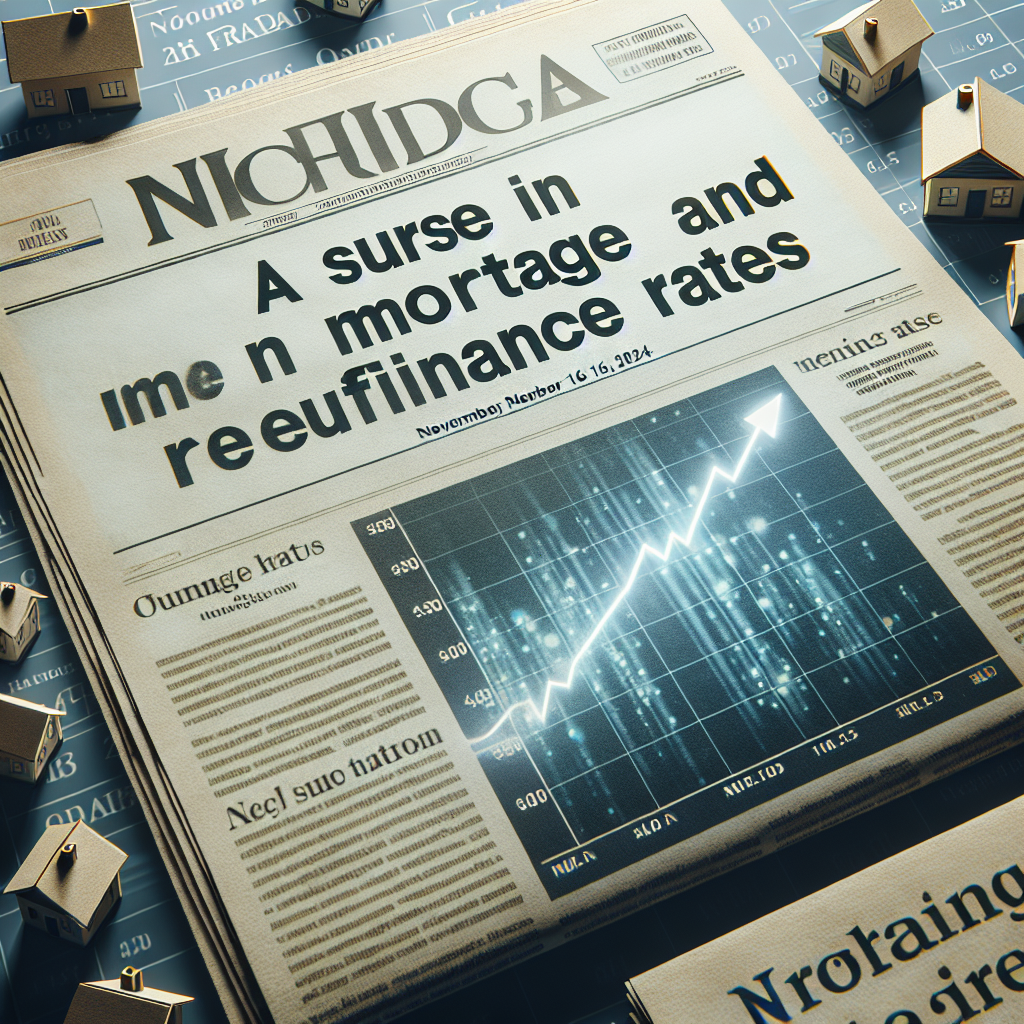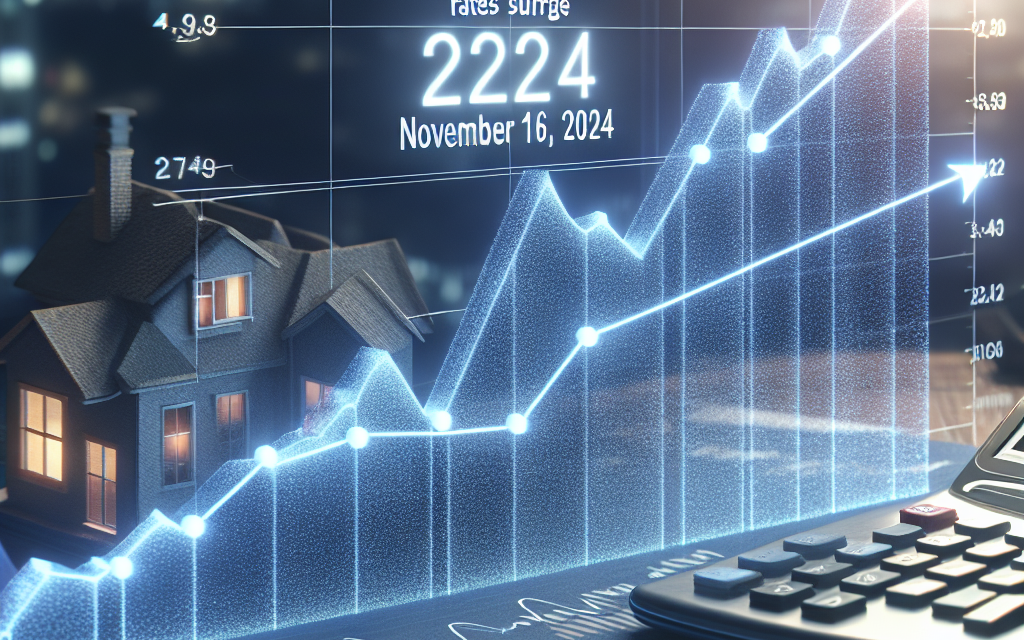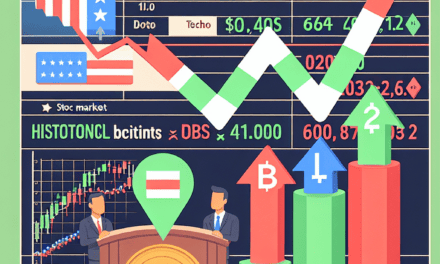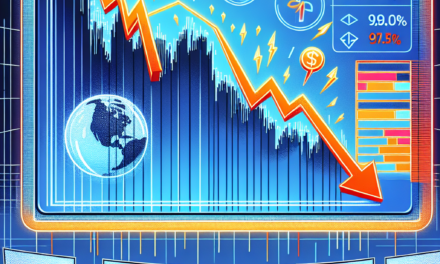“November 16, 2024: Navigating the Wave of Rising Mortgage and Refinance Rates”
Introduction
On November 16, 2024, the financial landscape experienced a significant shift as mortgage and refinance rates surged, impacting homeowners and prospective buyers across the nation. This unexpected rise in rates marked a departure from the relatively stable interest environment that had prevailed in recent years. The increase was driven by a combination of factors, including changes in monetary policy, inflationary pressures, and global economic uncertainties. As a result, borrowers faced higher costs for new mortgages and refinancing existing loans, prompting many to reassess their financial strategies. This development underscored the importance of staying informed and adaptable in a dynamic economic climate.
Impact Of Rising Mortgage Rates On Homebuyers
On November 16, 2024, the financial landscape for prospective homebuyers shifted dramatically as mortgage and refinance rates surged to levels not seen in over a decade. This sudden increase has significant implications for individuals looking to purchase homes, as well as those considering refinancing their existing mortgages. Understanding the impact of these rising rates is crucial for navigating the current housing market.
To begin with, the surge in mortgage rates directly affects the affordability of homes. As interest rates climb, the cost of borrowing increases, leading to higher monthly mortgage payments. For many potential homebuyers, this means that the dream of homeownership may become more elusive. The increased financial burden can disqualify some buyers from securing a mortgage, as lenders typically assess an applicant’s ability to repay based on their income and existing debt obligations. Consequently, higher rates can reduce the pool of eligible buyers, potentially slowing down the housing market.
Moreover, the rise in mortgage rates can also influence the types of homes that buyers can afford. With higher interest rates, the purchasing power of homebuyers diminishes, often forcing them to reconsider their options. This may lead to a shift in demand from more expensive properties to more modestly priced homes, as buyers adjust their expectations to align with their financial capabilities. As a result, the market for luxury homes may experience a slowdown, while demand for entry-level and mid-range properties could see an uptick.
In addition to affecting new homebuyers, the increase in rates has significant implications for current homeowners considering refinancing their mortgages. Refinancing is a common strategy used by homeowners to take advantage of lower interest rates, thereby reducing their monthly payments or shortening the term of their loan. However, with rates on the rise, the potential savings from refinancing diminish, making it a less attractive option for many. Homeowners who previously contemplated refinancing to access equity or lower their interest rates may now find that the costs outweigh the benefits.
Furthermore, the broader economic implications of rising mortgage rates cannot be overlooked. As borrowing becomes more expensive, consumer spending may decrease, potentially slowing economic growth. The housing market, a key driver of economic activity, could experience a deceleration as both buyers and sellers adjust to the new financial realities. This, in turn, may have a ripple effect on related industries, such as construction, real estate, and home improvement, which rely heavily on a robust housing market.
Despite these challenges, it is important to note that rising mortgage rates are not without precedent. Historically, the housing market has demonstrated resilience in the face of fluctuating interest rates. While the immediate impact may be a cooling of the market, over time, buyers and sellers often adapt to new conditions. Additionally, financial institutions may introduce innovative mortgage products or incentives to attract buyers, helping to stabilize the market.
In conclusion, the surge in mortgage and refinance rates on November 16, 2024, presents significant challenges for homebuyers and homeowners alike. The increased cost of borrowing affects affordability, purchasing power, and refinancing decisions, while also having broader economic implications. However, the housing market’s historical resilience suggests that, with time, it will adjust to these new conditions. As stakeholders navigate this evolving landscape, understanding the impact of rising rates will be essential for making informed decisions in the housing market.
Strategies For Refinancing Amidst Rate Increases
As of November 16, 2024, the financial landscape has been significantly impacted by a surge in mortgage and refinance rates, prompting homeowners and potential buyers to reassess their financial strategies. This increase in rates, driven by a combination of economic factors including inflationary pressures and monetary policy adjustments, has created a challenging environment for those looking to refinance their existing mortgages. However, despite these challenges, there are strategic approaches that can be employed to navigate this complex situation effectively.
Firstly, it is crucial for homeowners to conduct a thorough assessment of their current financial situation. This involves evaluating the terms of their existing mortgage, including the interest rate, remaining balance, and the duration of the loan. By understanding these elements, homeowners can better determine whether refinancing is a viable option. In some cases, even with higher rates, refinancing might still offer benefits such as reducing monthly payments or consolidating debt, particularly if the homeowner has built significant equity in their property.
Moreover, timing plays a critical role in the refinancing process. While rates are currently on the rise, they are subject to fluctuations based on economic conditions and policy changes. Therefore, staying informed about market trends and forecasts can provide homeowners with the opportunity to act swiftly when rates show signs of stabilizing or decreasing. Engaging with financial advisors or mortgage brokers who have a keen understanding of the market can also provide valuable insights and guidance on the optimal timing for refinancing.
In addition to timing, exploring different refinancing options is essential. Homeowners should consider various types of loans, such as fixed-rate mortgages, adjustable-rate mortgages (ARMs), or cash-out refinancing, each of which offers distinct advantages and potential drawbacks. For instance, while fixed-rate mortgages provide stability with consistent payments, ARMs might offer lower initial rates that could be beneficial if the homeowner plans to sell the property before the rate adjusts. On the other hand, cash-out refinancing can be an attractive option for those looking to leverage their home equity for other financial needs, such as home improvements or paying off high-interest debt.
Furthermore, improving one’s credit score can significantly impact the refinancing process. A higher credit score often translates to more favorable loan terms and lower interest rates. Homeowners should take proactive steps to enhance their creditworthiness by paying down existing debts, avoiding new credit inquiries, and ensuring timely payments on all financial obligations. This not only increases the likelihood of securing a better rate but also strengthens the homeowner’s overall financial position.
Lastly, it is important to consider the long-term implications of refinancing. While the immediate goal may be to lower monthly payments or access cash, homeowners should also evaluate how refinancing aligns with their broader financial objectives. This includes considering the total cost of the loan over its lifetime, potential tax implications, and the impact on future financial flexibility.
In conclusion, while the current surge in mortgage and refinance rates presents challenges, it also offers an opportunity for homeowners to reassess and refine their financial strategies. By conducting a comprehensive evaluation of their financial situation, staying informed about market trends, exploring various refinancing options, improving credit scores, and considering long-term goals, homeowners can navigate this complex environment with greater confidence and make informed decisions that align with their financial aspirations.
Historical Comparison: Mortgage Rate Trends Over The Decades
On November 16, 2024, mortgage and refinance rates experienced a significant surge, marking a pivotal moment in the financial landscape. To understand the implications of this development, it is essential to examine the historical trends of mortgage rates over the decades. By doing so, we can gain insights into the factors that have influenced these rates and how they have evolved over time.
In the mid-20th century, mortgage rates were relatively stable, reflecting a period of economic growth and stability. During the 1950s and 1960s, rates typically hovered around 4% to 6%, supported by a robust post-war economy and government policies that encouraged homeownership. However, as the 1970s unfolded, the economic environment began to shift dramatically. The oil crisis, coupled with rising inflation, led to a sharp increase in mortgage rates, which peaked at an unprecedented 18% in the early 1980s. This period of high rates was a direct response to the Federal Reserve’s aggressive monetary policy aimed at curbing inflation.
As the 1980s progressed, the economy began to stabilize, and mortgage rates gradually declined. By the 1990s, rates had settled into a more moderate range of 7% to 9%, reflecting a period of economic expansion and technological advancement. The introduction of new financial products and the globalization of markets also played a role in shaping mortgage rate trends during this time. The late 1990s and early 2000s saw further declines in rates, driven by a combination of low inflation, increased competition among lenders, and the Federal Reserve’s accommodative monetary policy.
The financial crisis of 2008 marked another turning point in the history of mortgage rates. In response to the crisis, central banks around the world implemented unprecedented measures to stabilize the financial system, leading to a prolonged period of historically low interest rates. By the early 2010s, mortgage rates had fallen to record lows, with 30-year fixed rates averaging around 3% to 4%. This environment of low rates spurred a wave of refinancing activity and contributed to a recovery in the housing market.
However, as the global economy began to recover, central banks signaled a shift towards normalizing monetary policy. By the late 2010s and early 2020s, mortgage rates began to rise gradually, reflecting expectations of higher inflation and economic growth. The COVID-19 pandemic temporarily disrupted this trend, as central banks once again lowered rates to support economic activity. Nevertheless, as the world emerged from the pandemic, the focus shifted back to addressing inflationary pressures, leading to a renewed upward trajectory in mortgage rates.
The surge in mortgage and refinance rates on November 16, 2024, can be seen as part of this broader historical context. It underscores the dynamic interplay between economic conditions, monetary policy, and global events that have shaped mortgage rate trends over the decades. As we look to the future, understanding these historical patterns can provide valuable insights for policymakers, lenders, and borrowers alike. By recognizing the factors that drive mortgage rates, stakeholders can better navigate the complexities of the housing market and make informed decisions in an ever-evolving financial landscape.
Expert Predictions: Future Of Mortgage Rates Post-Surge

As the financial landscape continues to evolve, the recent surge in mortgage and refinance rates on November 16, 2024, has prompted widespread speculation about the future trajectory of these rates. This unexpected increase has left many potential homeowners and current mortgage holders questioning what lies ahead. To understand the potential future of mortgage rates post-surge, it is essential to consider the factors that have contributed to this rise and the expert predictions that are shaping expectations.
The surge in mortgage and refinance rates can be attributed to a confluence of economic factors. Primarily, the Federal Reserve’s monetary policy has played a significant role. In response to persistent inflationary pressures, the Federal Reserve has implemented a series of interest rate hikes throughout the year. These measures, aimed at curbing inflation, have inevitably led to higher borrowing costs across the board, including for mortgages. Additionally, global economic uncertainties, such as geopolitical tensions and supply chain disruptions, have further exacerbated market volatility, contributing to the upward pressure on interest rates.
In light of these developments, experts are closely monitoring the Federal Reserve’s future actions. Many analysts predict that the central bank will continue its cautious approach, balancing the need to control inflation with the risk of stifling economic growth. Consequently, mortgage rates may remain elevated in the short term, as the Federal Reserve assesses the impact of its policies on the broader economy. However, some experts suggest that if inflationary pressures begin to ease, there could be room for a gradual reduction in interest rates, potentially leading to a stabilization of mortgage rates.
Moreover, the housing market’s response to these rate changes is another critical factor to consider. Historically, higher mortgage rates tend to dampen housing demand, as potential buyers face increased borrowing costs. This could lead to a cooling of the housing market, with slower price appreciation and reduced competition among buyers. In turn, this may prompt lenders to offer more competitive rates to attract borrowers, potentially mitigating the impact of the initial surge.
Furthermore, the role of government policies and initiatives cannot be overlooked. In recent years, there has been a growing emphasis on promoting affordable housing and homeownership. Policymakers may introduce measures to support first-time homebuyers or provide incentives for refinancing, which could influence the mortgage landscape. These initiatives, coupled with market dynamics, could play a pivotal role in shaping the future of mortgage rates.
In conclusion, while the recent surge in mortgage and refinance rates has created uncertainty, expert predictions offer valuable insights into the potential future trajectory of these rates. The interplay between Federal Reserve policies, housing market dynamics, and government initiatives will be crucial in determining whether rates stabilize or continue to fluctuate. As borrowers and industry stakeholders navigate this evolving landscape, staying informed and adaptable will be essential. By closely monitoring economic indicators and policy developments, individuals can make informed decisions regarding their mortgage and refinancing options, ensuring they are well-prepared for whatever the future may hold.
How To Lock In A Good Rate During A Surge
As the financial landscape shifts, November 16, 2024, marks a significant day for homeowners and prospective buyers as mortgage and refinance rates experience a notable surge. This development has left many individuals concerned about the implications for their financial plans. However, understanding how to navigate this environment can empower borrowers to secure favorable terms despite the rising rates. By employing strategic approaches, individuals can effectively lock in a good rate during this period of volatility.
To begin with, it is crucial to stay informed about the factors contributing to the rate surge. Economic indicators such as inflation, employment rates, and Federal Reserve policies play a pivotal role in influencing mortgage rates. By keeping abreast of these developments, borrowers can anticipate potential rate changes and make informed decisions. Additionally, consulting with financial advisors or mortgage professionals can provide valuable insights into market trends and help borrowers understand the broader economic context.
Once equipped with this knowledge, the next step is to assess personal financial readiness. A strong credit score remains a key determinant in securing favorable mortgage terms. Therefore, individuals should review their credit reports for any discrepancies and take steps to improve their credit standing if necessary. Paying down existing debts, avoiding new credit inquiries, and ensuring timely bill payments can significantly enhance one’s credit profile. A higher credit score not only increases the likelihood of loan approval but also positions borrowers to negotiate better rates.
Moreover, exploring different loan options is essential in this environment. Fixed-rate mortgages offer stability by locking in a consistent interest rate over the life of the loan, shielding borrowers from future rate hikes. On the other hand, adjustable-rate mortgages (ARMs) may initially offer lower rates, but they carry the risk of future increases. Evaluating the pros and cons of each option in light of personal financial goals and risk tolerance is crucial. Consulting with mortgage lenders to understand the nuances of each product can aid in making an informed choice.
Timing is another critical factor in securing a good rate. While it may be tempting to wait for rates to decrease, predicting market movements is inherently uncertain. Instead, borrowers should consider locking in a rate as soon as they find a favorable offer. Rate locks typically last between 30 to 60 days, providing a buffer against potential increases during the loan processing period. However, it is important to confirm the terms and conditions of the rate lock with the lender to avoid any surprises.
Furthermore, shopping around for the best deal is a prudent strategy. Different lenders may offer varying rates and terms, so obtaining multiple quotes can provide a comprehensive view of available options. Online comparison tools and mortgage brokers can facilitate this process by streamlining the search for competitive rates. By leveraging these resources, borrowers can identify lenders who are willing to offer more favorable terms, even amidst a rate surge.
In conclusion, while the surge in mortgage and refinance rates on November 16, 2024, presents challenges, it also offers opportunities for informed borrowers to secure advantageous terms. By staying informed about economic trends, maintaining a strong credit profile, exploring diverse loan options, timing rate locks strategically, and shopping around for the best deals, individuals can navigate this period of volatility with confidence. Ultimately, a proactive and informed approach will empower borrowers to make sound financial decisions, ensuring stability and success in their homeownership journey.
The Role Of The Federal Reserve In Mortgage Rate Changes
On November 16, 2024, mortgage and refinance rates experienced a significant surge, capturing the attention of homeowners, potential buyers, and financial analysts alike. This development can be largely attributed to the actions and policies of the Federal Reserve, which plays a pivotal role in influencing interest rates across the United States. Understanding the connection between the Federal Reserve’s decisions and mortgage rate fluctuations is crucial for comprehending the broader economic landscape.
The Federal Reserve, often referred to as the Fed, is the central banking system of the United States. It is tasked with promoting maximum employment, stabilizing prices, and moderating long-term interest rates. One of the primary tools at the Fed’s disposal is the manipulation of the federal funds rate, which is the interest rate at which banks lend to each other overnight. Changes in this rate can have a ripple effect throughout the economy, influencing various interest rates, including those for mortgages.
When the Federal Reserve raises the federal funds rate, borrowing costs for banks increase. Consequently, banks often pass these higher costs onto consumers in the form of increased interest rates on loans, including mortgages. This is precisely what occurred in the lead-up to November 16, 2024. The Fed, in response to rising inflationary pressures and a robust labor market, opted to increase the federal funds rate. This decision was made to curb inflation and ensure that the economy does not overheat, but it also resulted in higher mortgage and refinance rates.
Moreover, the Fed’s communication strategy plays a crucial role in shaping market expectations. Through public statements and economic projections, the Fed signals its future policy intentions. In recent months, the Fed had indicated a more hawkish stance, suggesting that further rate hikes were likely if inflation remained persistent. This forward guidance led to anticipatory actions by lenders, who adjusted their mortgage rates in anticipation of future increases in the federal funds rate.
In addition to the direct impact of the federal funds rate, the Federal Reserve’s actions in the bond market also influence mortgage rates. The Fed engages in open market operations, buying and selling government securities to influence the money supply and interest rates. When the Fed purchases long-term securities, it can help lower long-term interest rates, including those for mortgages. Conversely, when the Fed reduces its holdings or signals a reduction in bond purchases, long-term rates can rise. In 2024, the Fed’s decision to taper its bond-buying program contributed to the upward pressure on mortgage rates.
It is important to note that while the Federal Reserve’s policies are a significant factor in mortgage rate changes, they are not the sole determinant. Other factors, such as global economic conditions, investor sentiment, and fiscal policies, also play a role. However, the Fed’s influence is undeniably substantial, and its decisions are closely monitored by market participants.
In conclusion, the surge in mortgage and refinance rates on November 16, 2024, underscores the critical role of the Federal Reserve in shaping the economic environment. By adjusting the federal funds rate and engaging in open market operations, the Fed directly and indirectly influences mortgage rates. As such, understanding the Fed’s actions and intentions is essential for anyone navigating the housing market or making financial decisions related to borrowing. As the economic landscape continues to evolve, the interplay between the Federal Reserve’s policies and mortgage rates will remain a key area of focus for analysts and consumers alike.
Financial Planning Tips For Homeowners Facing Higher Rates
As November 16, 2024, approaches, homeowners are bracing for a significant shift in the financial landscape, with mortgage and refinance rates experiencing a notable surge. This development has prompted many to reassess their financial strategies, particularly those who are either in the process of purchasing a home or considering refinancing their existing mortgage. Understanding the implications of these rising rates is crucial for homeowners aiming to maintain financial stability and make informed decisions.
To begin with, it is essential to comprehend the factors contributing to the increase in mortgage and refinance rates. Economic indicators such as inflation, employment rates, and monetary policy decisions by central banks play a pivotal role in influencing these rates. As inflationary pressures mount and central banks respond by adjusting interest rates to curb inflation, the cost of borrowing inevitably rises. Consequently, homeowners must navigate this evolving environment with a strategic approach to financial planning.
One of the primary considerations for homeowners facing higher rates is the impact on monthly mortgage payments. As rates climb, so do the costs associated with servicing a mortgage. For those with adjustable-rate mortgages, the effect can be immediate and significant, as their payments fluctuate with market conditions. In contrast, homeowners with fixed-rate mortgages may find solace in the stability of their payments, although they may miss out on potential savings if rates were to decrease in the future. Therefore, evaluating the type of mortgage and its terms is a critical step in adapting to the current rate environment.
Moreover, refinancing decisions become more complex in the context of rising rates. While refinancing can offer benefits such as lower monthly payments or a shorter loan term, the increased rates may offset these advantages. Homeowners considering refinancing should conduct a thorough cost-benefit analysis, taking into account the closing costs, the new interest rate, and the break-even point at which the savings from refinancing outweigh the costs incurred. This careful assessment will help determine whether refinancing is a prudent choice under the prevailing conditions.
In addition to evaluating mortgage options, homeowners should also focus on broader financial planning strategies to mitigate the impact of higher rates. Building a robust emergency fund is more important than ever, providing a financial cushion in case of unexpected expenses or income fluctuations. Additionally, reducing high-interest debt, such as credit card balances, can free up resources to manage increased mortgage payments. By prioritizing debt reduction, homeowners can improve their overall financial health and resilience.
Furthermore, exploring opportunities to increase income can be a valuable strategy in offsetting the burden of higher mortgage payments. This might involve seeking additional employment, investing in skills development to enhance career prospects, or exploring passive income streams. By diversifying income sources, homeowners can create a more secure financial foundation.
Finally, consulting with financial advisors or mortgage professionals can provide valuable insights tailored to individual circumstances. These experts can offer guidance on navigating the complexities of the current market, helping homeowners make informed decisions that align with their long-term financial goals.
In conclusion, the surge in mortgage and refinance rates as of November 16, 2024, presents both challenges and opportunities for homeowners. By understanding the factors driving these changes and implementing strategic financial planning measures, homeowners can effectively manage the impact of higher rates and safeguard their financial well-being. Through careful evaluation of mortgage options, prudent debt management, and proactive income strategies, homeowners can navigate this evolving landscape with confidence and resilience.
Q&A
1. **What are the current mortgage rates as of November 16, 2024?**
– Mortgage rates have surged to an average of 7.5% for a 30-year fixed-rate mortgage.
2. **How do the current refinance rates compare to last month?**
– Refinance rates have increased by 0.3 percentage points compared to last month, now averaging 7.3% for a 30-year fixed refinance.
3. **What factors are contributing to the surge in mortgage rates?**
– The surge is attributed to recent Federal Reserve interest rate hikes and persistent inflationary pressures.
4. **How are homebuyers reacting to the increased mortgage rates?**
– Many homebuyers are pausing their purchasing plans, leading to a slowdown in the housing market.
5. **What impact is the rate surge having on the housing market?**
– The housing market is experiencing reduced demand, with fewer home sales and a slight increase in housing inventory.
6. **Are there any predictions for future mortgage rate trends?**
– Analysts predict that rates may stabilize or slightly decrease if inflation shows signs of easing and the Federal Reserve pauses rate hikes.
7. **What advice are financial experts giving to potential homebuyers?**
– Experts advise potential homebuyers to consider adjustable-rate mortgages or wait for potential rate decreases before committing to a purchase.
Conclusion
On November 16, 2024, mortgage and refinance rates experienced a significant surge, reflecting broader economic trends and monetary policy shifts. This increase can be attributed to a combination of factors, including inflationary pressures, changes in central bank interest rates, and evolving market conditions. As a result, potential homebuyers and those looking to refinance existing mortgages may face higher borrowing costs, impacting affordability and potentially cooling the housing market. This development underscores the importance of closely monitoring economic indicators and financial policies that influence interest rates, as they play a crucial role in shaping the real estate landscape and broader economic health.





